ปาฐกถา พระไตรปิฎกสากล
ปาฐกถา วันพระไตรปิฎกสากล พ.ศ. 2551
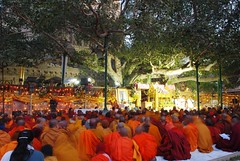
โดย ดร. จี.เอ. โสมรัตน์
ศาสตราจารย์ภาษาบาฬีและพุทธาสตรศึกษาแห่งมหาวิทยาลัยเปราเดนิยะ

เนื่องในโอกาสวันพระไตรปิฎกสากล
จัดโดยกองทุนสนทนาธัมม์นำสุขแห่งศรีลังกา ณ สัมโพธิวิหาร
กรุงโคลัมโบ ประเทศศรีลังกา
6 มีนาคม พ.ศ. 2551
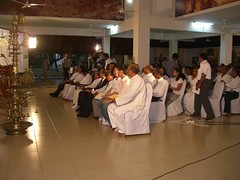

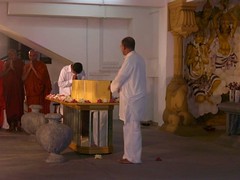
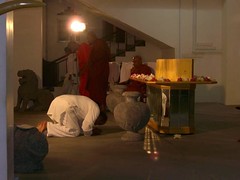
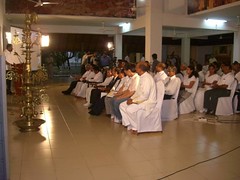
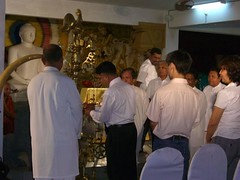
1. นมัสการพระเถรานุเถระ ฯพณฯ
ประธานรัฐสภาแห่งศรีลังกา ฯพณฯ เอกอัครราชทูตไทย ณ กรุงโคลัมโบ
และอุปทูตสาธารณรัฐประชาชนจีน ประธานสมาคมพุทธแห่งศรีลังกา
ประธานกองทุนสนทนาธัมม์นำสุขฯ และผู้มีเกียรติทั้งหลาย
2. ในโอกาสอันศักดิ์สิทธิ์เนื่องในวันพระไตรปิฎกสากล (World
Tipiṭaka Day)
และในวาระครบรอบปีที่สามแห่งการประดิษฐานพระไตรปิฎกสากลเป็นปฐมฤกษ์
ที่พระราชทานโดยสมเด็จพระเจ้าพี่นางเธอ เจ้าฟ้ากัลยาณิวัฒนา
กุลเชษฐ์แห่งพระราชวงศ์ ข้าพเจ้าของกล่าวอธิบายสั้นๆ
แก่สมาคมผู้ทรงเกียรตินี้เกี่ยวกับพระไตรปิฎกบาฬีฉบับสังคายนาสากลนานาชาติ
อักษรโรมัน
และความแตกต่างของพระไตรปิฎกบาฬีฉบับนี้กับพระไตรปิฎกบาฬีฉบับอื่นๆ
ที่มีอยู่ในโลก
3. ที่จบลงนั้น มร. สุรนิมาละ เสนารัตเน และคณะ
ได้อัญเชิญพระไตรปิฎกบาฬี ฉบับมหาสังคายนาสากลนานาชาติ
"พระไตรปิฎกสากล "
(World Tipiṭaka Edition) ชุด 40 เล่ม
ด้วยความเคารพนอบน้อมมาประดิษฐานบนแท่นพระไตรปิฎกแก้ว
พระไตรปิฎกฉบับนี้ เป็นชุดที่เป็นมติของการประชุมสังคายนาฉัฏฐสังคีติ
(Chaṭṭhasaṅgīt)
ซึ่งได้มีการสวดสังวัธยายร่วมกันโดยผู้เข้าร่วมประชุม
ประกอบด้วยพระสงฆ์และผู้เชี่ยวชาญ 2,500 ท่าน
เพื่อแสดงความเห็นชอบและรับรอง การทำงานตรวจสอบนี้ได้เริ่มตั้งแต่
พ.ศ. 2495 เป็นต้นมา ในประเทศศรีลังกา
ก็ได้มีการจัดตั้งสภาพระไตรปิฎกเพื่อจุดประสงค์นี้ด้วย
สมาชิกผู้เชี่ยวชาญพระไตรปิฎกบาฬีทั้งคณะสงฆ์และฆราวาส
ได้ทำการตรวจสอบและส่งต้นฉบับไปก่อนที่จะได้ส่งความเห็นตามไปให้แก่คณะบรรณาธิการในประเทศพม่า
ดังนั้น
คณะพระสงฆ์และฆราวาสแห่งศรีลังกาได้ให้การรับรองแก่ที่ประชุมสังคายนานานาชาติ
ถึงสองครั้งในสองวาระ
4. การเตรียมการจัดสร้างพระไตรปิฎกบาฬี ฉบับมหาสังคายนาสากลนานาชาติ
อักษรโรมัน ได้เริ่มขึ้นเมื่อปี พ.ศ. 2542 โดยมี พันตรี สุรธัช บุนนาค
เป็นนายกโครงการ จุดประสงค์ประการแรกของโครงการพระไตรปิฎกสากล คือ
การนำพระไตรปิฎก ฉบับฉัฏฐสังคีติ (Chaṭṭhasaṅgīt) ภาษาบาฬี
มาถอดจากอักษรพม่า เพื่อจัดพิมพ์เป็นอักษรโรมัน (Roman
script) และจัดพิมพ์เผยแผ่แก่สถาบันสำคัญนานาชาติทั่วโลก
5. คณะโครงการพระไตรปิฎกสากลในกองทุนสนทนาธัมม์นำสุขฯ
และผู้ศึกษาค้นคว้า ได้พบข้อแตกต่างที่สำคัญของการจัดพิมพ์
(ดูรายละเอียดเอกสารจดหมายเหตุ)
ซึ่งเป็นข้อบกพร่องและผิดพลาดในพระไตรปิฎกบาฬีฉบับซีดีรอม อักษรโรมัน
ของท่านโกเอ็นก้าแห่งสมาคมวิจัยวิปัสสนาแห่งอินเดีย
และเมื่อคณะสนทนาธัมม์นำสุขฯ ได้เปรียบเทียบพระไตรปิฎก
ซีดีรอมอักษรโรมัน ของสมาคมวิจัยวิปัสสนากับฉบับสังคายนานานาชาติ
อักษรพม่า ก็ได้พบข้อแตกต่างที่สำคัญระหว่างทั้งสองฉบับด้วย นอกจากนี้
เมื่อได้เปรียบพระไตรปิฎกบาฬีฉบับสังคายนานานาชาติ อักษรพม่า
กับพระไตรปิฎกบาฬี ฉบับซีดีรอมอักษรโรมัน
กับต้นฉบับพระไตรปิฎกอักษรอักษรพม่าที่เป็นผลของการประชุมสังคายนา
ก็ได้พบอีกว่าในเนื้อหาภาษาบาฬมีข้อบกพร่องและความผิดพลาดสำคัญ
ทั้งที่จงใจและไม่จงใจ
6. คณะทำงานโครงการพระไตรปิฎกสากลในกองทุนสนทนาธัมม์นำสุขฯ
พบว่าหนังสือพระไตรปิฎกเล่มที่จัดพิมพ์ขึ้นทันทีหลังการประชุมสังคายนา(2496-2499)
เป็นฉบับที่สนับสนุนต้นฉบับที่เป็นมติของการสังคายนานานาชาติ
แต่หนังสือชุดที่จัดพิมพ์ขึ้นภายหลัง(2500-2506)
เป็นชุดที่สนับสนุนต้นฉบับท้องถิ่นดั้งเดิมของพม่าอย่างน่าตกใจ
ด้วยเหตุนี้
คณะทำงานสนทนาธัมม์นำสุขจึงได้ดำเนินตามพระบัญชาของสมเด็จพระญาณสังวร
สมเด็จพระสังฆราช สกลมหาสังฆปริณายก
โดยตกลงปรับปรุงต้นฉบับสากลให้บริสุทธิ์
และจัดพิมพ์ตามมติของที่ประชุมสังคายนานานาชาติเป็นอักษรโรมัน
โดยใช้วิธีการตามประเพณีดั้งเดิม
และวิธีการสมัยใหม่ในการปรับปรุงคัมภีร์ที่เก่าแก่นี้
7. "พระไตรปิฎก" แปลว่า ตะกร้าสามใบ หมายถึง
การแบ่งคำสอนของพระสัมมาสัมพุทธเจ้าเป็นสามกลุ่ม
และยังหมายถึงกระบวนวิธีการสืบทอดด้วย
ระบบการแบ่งหมวดหมู่คำสอนของพระไตรปิฎกทำให้ง่ายต่อการรวบรวมเนื้อหาคำสอนที่มากมายมหาศาล
เมื่อคำสอนเหล่านี้ได้จัดแบ่งเป็นหมวดหมู่ในแต่ละตะกร้าแล้ว
ทำให้ง่ายต่อการสืบต่อในแต่ละส่วนไปยังระบบการแบ่งหมวดหมู่คำสอนที่ได้จัดทำใว้ในสมัยพุทธกาล
คือ "นวังคสัตถุสาสน์" (ได้แก่ คำสั่งสอนของพระบรมศาสดามีองค์เก้า)
ตามการบันทึกตามประเพณีได้กล่าวว่า
การแบ่งหมวดหมู่คำสอนนี้ได้เริ่มมาตั้งแต่การประชุมสังคายนาครั้งที่หนึ่ง
8. คำสอนของพระสัมมาสัมพุทธเจ้าได้อนุรักษ์ไว้ด้วยวิธี "มุขปาฐะ"
(oral
tradition) (คือ สืบทอดท่องจำด้วยปากเปล่า) ตั้งแต่ ประมาณ พ.ศ.
433 หรือคริสศตวรรษที่ 1
ในการนี้มีวิธีการอย่างไรที่ภิกษุและภิกษุณีได้อนุรักษ์คำสอนอันศักดิ์สิทธิ์ในพระไตรปิฎกบาฬีสืบทอดมาถึงปัจจุบัน
?
9. ในระหว่างกระบวนการปรับปรุงพระไตรปิฎกสากล อักษรโรมัน ทั้ง 40
เล่มนี้
คณะสนทนาธัมม์นำสุขได้ใช้วิธีการสวดออกเสียงสังวัธยายเป็นภาษาบาฬี
พร้อมทั้งการตรวจทานพระไตรปิฎกบาฬีกับฉบับอื่นๆ รวม 14 ฉบับ
นอกจากนั้นโครงการพระไตรปิฎกสากล ยังได้ใช้เทคโนโลยีสมัยใหม่ล่าสุด
เรียกว่า "เทคโนโลยีธัมมะ" (Dhamma
Technology) ในการตรวจทานด้วย
10. พระไตรปิฎกบาฬีฉบับสากล อักษรโรมัน นี้แตกต่างจากฉบับอื่นอย่างไร
?
และเหตุใดโครงการสนทนาธัมม์นำสุขจึงได้เพียรพยายามจัดพิมพ์พระไตรปิฎกสากลขึ้นใหม่อีก
ทั้งๆ ที่มีพระไตรปิฎกฉบับต่างๆ แล้วมากมาย
และพระไตรปิฎกสากลอักษรโรมันนี้มีลักษณะพิเศษอย่างๆไร ?
11. ตัวอย่างประการแรกได้แก่ฉบับของสมาคมบาลีปกรณ์ (Pali Text
Society) ซึ่งข้าพเจ้าคุ้นเคย
เพราะข้าพเจ้าได้เคยเป็นบรรณาธิการปรับปรุงต้นฉบับในหนังสือชุดนี้
ซึ่งไม่ต้องสงสัยเลยว่าสมาคมบาลีปกรณ์ได้ทำหน้าที่อย่างดีเยี่ยมในการอนุรักษ์หนังสือภาษาบาฬี
(pali text) แต่หนังสือเหล่านั้นก็มิใช่พระไตรปิฎกบาฬี (Pāḷi
Tipiṭaka)
หนังสือภาษาบาฬีแต่ละชุดได้ถูกแก้ไขปรับปรุงโดยนักวิชาการแต่ละคน
เมื่อนักวิชาการเหล่านั้นเป็นบรรณาธิการแก้ไขเนื้อหาในแต่ละชุด
ท่านเหล่านั้นจะใช้ต้นฉบับพระไตรปิฎกต่างๆ ที่สามารถค้นหาได้
และก็จะแก้ใขปรับปรุงเนื้อหาต่างๆ
ซึ่งมีทั้งข้อจำกัดหรือไม่มีข้อจำกัดในความสามารถทางภาษาของแต่ละคน
ผลงานจะปรากฏในการจัดพิมพ์ภายใต้ชื่อตามความเป็นจริงของผู้เชี่ยวชาญนั้นๆ
นอกจากนี้หนังสือดังกล่าวยังเป็นผลของวิถีแห่งความนึกคิดของผู้เชี่ยวชาญนั้นๆ
ด้วย โดยเฉพาะ การอ้างอิง (reference) และการเลือก “คำต่าง” (variant
readings) ด้วย ดังนั้น
หนังสือภาษาบาฬีเหล่านั้นจึงมิอาจถือเป็นพระไตรปิฎกบาฬี หรือ
คัมภีร์ศักดิ์สิทธิ์ในพระพุทธศาสนาเถรวาทได้
12. สำหรับพระไตรปิฎกบาฬี ฉบับพุทธชยันติ อักษรสิงหล
ซึ่งเป็นฉบับที่พวกเราชาวศรีลังการู้จักกันดี
หนังสือเหล่านี้ได้รับการจัดทำโดยใช้ฐานข้อมูลจากต้นฉบับพระไตรปิฎกหนึ่งหรือสองฉบับ
บางครั้งบรรณาธิการได้แสดงความซื่อตรงต่อต้นฉบับอักษรสิงหลดังเดิม
และจากคัมภีร์อัฏฐกถา (ซึ่งเป็นภัมภีร์อธิบายพระไตรปิฎก)
หนังสือบางเล่มอาจเป็นเพียงการผสมของรูปแบบข้อมูลจากประเพณีต่างๆ
หนังสือบางฉบับก็เป็นเพียงการใช้ข้อมูลจากต้นฉบับพระไตรปิฎกบาฬีเพียงฉบับเดียวเท่านั้น
ฯพณฯ ประธานรัฐสภา เมื่อครั้งดำรงตำแหน่งรัฐมนตรีกระทรวงพระพุทธศาสนา
ได้ทำหน้าที่ตรวจสอบและปรับปรุงกระบวนการต่างๆ ของชุดนี้ อย่างไรก็ตาม
พระไตรปิฎกบาฬี อักษรสิงหล
มิได้ดำเนินตามมติของการประชุมสังคายนานานาชาติ
13. นอกจากนี้ยังมีฉบับอื่นๆ อีก
แต่เวลาไม่เพียงพอที่จะให้เราได้อธิบายฉบับต่างๆ โดยละเอียดได้
แต่สิ่งหนึ่งที่ชัดเจนคือ
พระไตรปิฎกบาฬีทุกฉบับล้วนมีจุดด้อยและจุดเด่น แต่พระไตรปิฎกบาฬี
ฉบับสังคายนาสากลนานาชาติ อักษรโรมัน
ได้มีกระบวนการจัดทำและสามารถผ่านพ้นข้อจำกัดทั้งหลาย
เพราะได้ตรวจสอบกับฉบับต่างๆ
ทั้งชุดที่จัดพิมพ์และชุดอิเล็กทรอนิกส์
14. สุดท้ายนี้ ข้าพเจ้าขอสอนสิ่งหนึ่งแก่ท่าน
พวกเราทั้งหลายในกองทุนสนทนาธัมม์นำสุข เรียกพระไตรปิฎกในภาษาบาฬีว่า
ติ-ปิ-ฏะ-กะ (Tipiṭaka) มิใช่คำว่า ตริ-ปิ-ฎะ-กะ
(Tripitaka) เพราะ ติปิฏกะ
เป็นศัพท์ภาษาบาฬีอันเป็นภาษาแห่งพระพุทธพจน์ของพระสัมมาสัมพุทธเจ้า
ซึ่งเป็นภาษาเก่าแก่ที่ได้อนุรักษ์คำสั่งสอนตั้งแต่ยุคแรก ด้วยเหตุนี้
พระบาฬีจึงเป็นภาษาอันศักดิ์สิทธิ์ของพระพุทธศาสนาเถรวาท
ข้าพเจ้าขอขอบคุณ มร. สุรนิมาละ เสนารัตเน
ประธานกองทุนสนทนาธัมม์นำสุขแห่งศรีลังกา
ในการจัดงานฉลองวันพระไตรปิฎกสากลอย่างยิ่งใหญ่
และขออำนวยพรให้ทุกท่านประสบสันติสุขทุกประการ.
The "World Tipiṭaka Day" Lecture 2008

Delivered by G.A. Somaratne, Ph.D.
Professor of Pāḷi & Buddhist Studies, University of
Peradeniya

On the occasion of
The World Tipiṭaka Day Ceremony & Seminar
Organized by the Dhamma Society Sri Lanka, at Sri Sambodhi Vihara
Colombo, Sri Lanka
March 6, B.E. 2551 (2008)






1. The Most Venerable Members of
the Mahāsaṃgha, Honorable Speaker of the Sri Lanka Parliament, His
Excellency the Ambassador of the Kingdom of Thailand to Sri Lanka,
Her Excellency the Deputy Ambassador of the People’s Republic of
China to Sri Lanka, the President of the Sri Lanka Bauddha
Mahasammelanaya, the President of the Dhamma Society Sri Lanka,
Distinguished Ladies and Gentlemen:
2. On this solemn occasion that marks both the World Tipiṭaka Day
and the Third Anniversary Day of the inaugural presentation of the
Buddhist Era 2500 Great International Council Pāḷi Tipiṭaka Edition
in Roman Script to Sri Lanka by Her Royal Highness Princess Galyani
Vadhana, the Royal Matriarch of Thailand, I will briefly explain to
this distinguished audience, what the International Council
Tipiṭaka Edition in Roman Script is and how that edition differs
from all other editions of the Tipiṭaka available in the world.
3. A short while ago, what Mr. Suranimala Senaratne and his team
respectfully and reverentially brought and placed on the
glass-table was the 40 volumes of the Great International Council
edition --the World Tipiṭaka in Roman Script. This edition is the
most refined version of the resolution of the Great International
Tipiṭaka Council held in Burma. In 1956, the Council’s Resolution
was recited by the participants, 2500 erudite monks and scholars,
to show their agreement and approval. It should be noted that the
actual editing work of the council draft had been done from 1952
onwards. There was also a Tipiṭaka Council established in Sri Lanka
for this purpose. The Sri Lankan members consisting of both Saṃgha
and lay Tipiṭaka scholars have carefully checked the sent draft
before submitting their suggestions to the editorial board in
Burma. Therefore, the erudite monks and scholars of Sri Lanka have
given their approval to the council draft twice at two stages.
4. The preparation process of the Great International Council
Tipiṭaka Edition in Roman Script was launched in 1999 by the Dhamma
Society under the chancellorship of Major Suradhaj Bunnag. The
initial aim of the World Tipiṭaka Project was to transliterate the
Chaṭṭhasaṅgīti (sixth council) edition into Roman Script and
distribute the copies of the published edition to recognized
international institutions worldwide.
5. The members of Dhamma Society's World Tipiṭaka Project and the
research team, however, found serious printing mistakes and errors
in Mr. S.N. Goenka’s Research Institution’s CD Rom Tipiṭaka version
in Roman Script. They compared it with the Great International
Council Edition in Burmese script. The researchers found a
noteworthy difference between the two. Further, when they compared
the two versions with the original draft that the council actually
used and agreed, they found some serious voluntary and involuntary
mistakes crept into the texts. The research and editing teams found
that volumes that came out in printed form in the years soon after
the council have genuinely sided with the actual council resolution
but the volumes that came later, particularly under the leadership
of the new Tipiṭaka Board, are alarmingly siding with the Burmese
textual tradition, disregarding the Council’s resolution.
Therefore, the Project members of the Dhamma Society, following the
advice of His Holiness the Supreme Patriarch of Thailand decided to
refine and publish the Council’s actual draft resolution in Roman
script by utilizing both the traditional and modern methods of
editing ancient texts.
6. The word Tipiṭaka means three baskets. It signifies not only the
classification of the Buddha’s teachings into three groups but also
the process of transmission. Classification of the teachings in
terms of the Tipiṭaka makes it easier to collect and arrange a vast
quantity of teachings. When the classified teachings are in
different baskets, it is easier to hand over each basket to the
next generation. The earliest classification of the teachings,
perhaps the classification practiced at the time of the Buddha, was
known as the Master’s teachings in nine limbs
(Navaṅgasatthusāsana). According to the traditional accounts, from
the first council onwards the Tipiṭaka classification came into
effect.
7. The Buddha’s teachings were preserved first orally and then from
the first century AD in writing. How have the monks and nuns
preserved this sacred Tipiṭaka? Even during the written
transmission never neglected was the memorization and recitation.
The correctness and the accuracy of the texts were checked by
utilizing not only the written copies but also the memorized
recitations. Through the process of recitation, the written texts
were corrected by comparing them with the memorized texts. The
memorized oral texts and the correct pronunciations and recitations
were improved by checking them against the written texts.
8. During the refining process of the 40 volumes, the Dhamma
Society utilized the recitation process as well as the 14 printed
editions. The Society utilized also the most up to date modern
Technology, what it calls, the Dhamma Technology.
9. How does this Tipiṭaka differ from all others? Why did the
Dhamma Society endeavor to publish another in the midst of many
other Tipiṭaka editions? What is unique about the Great
International Council Tipiṭaka Edition in Roman Script?
10. First I take the Pali Text Society edition (PTS), one that I am
very familiar with, for I have also edited a text for the series.
There is no doubt that PTS has done a remarkable job in preserving
Pali texts, but, unfortunately, not the Tipiṭaka. Each text has
been edited by individual scholars. When the scholar edits a text
for this series, she/he picks up several manuscripts that are
available to her or him; then s/he edits the text supported by
her/his limited or unlimited mastery of the language. The product
appears in published form rightly under the name of the scholar who
edited the text. It also comes with the ideology of the scholar,
particularly with reference to selecting variant readings. As such,
these texts cannot be regarded as the Tipiṭaka or the sacred canon
of the Buddhists.
11. The Buddhajayanti Tipiṭaka Edition is one we Sri Lankans are
mostly familiar with. These volumes have been prepared sometimes
based on one or two manuscripts. Sometimes, the editors have become
very faithful to the Sinhala manuscript tradition and commentaries.
Some volumes in the series are mere mixtures of various traditions.
Some others are merely based on a single manuscript. Our Honorable
Speaker of the Parliament, when he was the Minister of the
Buddhasāsana worked towards expediting and completing the editing
and publishing process of the series. This edition, however, does
not follow the resolution of an International Council.
12. Then there are other editions as well. But the time does not
allow us to explain them in detail. One thing is clear. All these
editions have their own limitations and strengths. The Great
International Council Edition in Roman Script transcends them all
for it has been checked against all the printed and electronic
versions of the Tipiṭaka during its refining process.
13. Finally, I must also teach you something. We in the Dhamma
Society use the word Tipiṭaka, not Tripitaka. Tipiṭaka is in Pāḷi.
Pāḷi is, if not the language of the Buddha, the most ancient
language in which the earliest teachings of the Buddha are
preserved. Therefore, it is the sacred language of the Tipiṭaka,
and of the Theravada Buddhists.
14. While thanking Mr. Suranimala Senaratne, the President of the
Dhamma Society Sri Lanka, for organizing this grand World Tipiṭaka
Day celebration, I wish all of you peace and happiness.
ความเห็น (0)
ไม่มีความเห็น